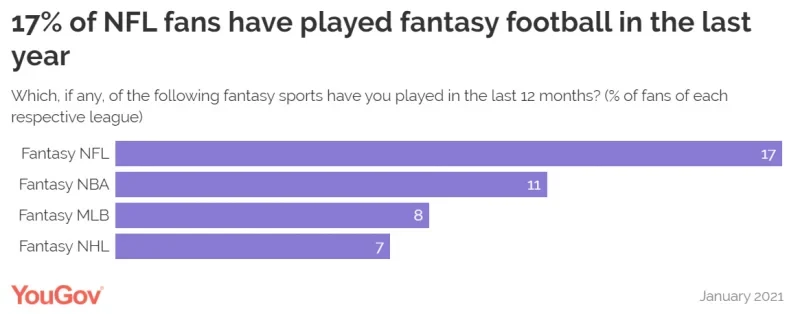
Fantasy sports in the US: who is playing?
Fantasy sports have become big business in recent years with many people across the United States playing for money. The sector has enjoyed a huge amount of growth with no signs of slowing as providers move into sportsbook betting while laws are relaxed across many states.
In the latest headline-grabbing move spurred by the law changes, Irish-based Flutter plc increase its stake in the leading fantasy sports provider FanDuel to 95% through a US$4-billion acquisition of a further 37.2% of the business in December 2020.
Fantasy is big business on its own, but it also has the potential to increase engagement in sporting events and increase engagement for sports news and content that helps fantasy players gain an edge over their opponents.
But who plays fantasy sports? YouGov has been collecting data on this for some time and our analysis shows that 15% of US adults over the age of 21 say they have played fantasy sports at least once in the past 12 months, including 21% of men and 8% of women. Over half (58%) of players are aged 25-44. Those who have played fantasy sports in the last year are around 30% more likely to report a gross household income above US$80,000.
There are also some interesting differences by ethnicity. While 15% of the population has played fantasy sports in the past 12 months, this figure increases to 30% of Asian-American, 17% of Hispanic Americans, 18% of Black Americans, but only 12% of white Americans. For all four groups, fantasy NFL (National Football League) is most popular, but Asian-Americans over-index strongly for all fantasy sports.
Let’s look at how many fans of each of the major sporting leagues engage in fantasy sports.
Nearly one in five (17%) of NFL fans – those who say they are somewhat interested in the league or it’s one of their top interests – have played fantasy football in the last 12 months, by far the highest rate of any US sport fanbase. This is likely since college-level football and the NFL are the most popular sports in the country.

The percentage of fans of the NBA (National Basketball Association), the MLB (Major League Baseball) and the NHL (National Hockey League) who have participated in fantasy leagues in each of those sports over the last year hovers between 7% and 11%. These findings from YouGov’s data presents a growth opportunity for the industry in other leagues. We know these fanbases are playing fantasy sports: these targeted audiences are all more likely to play fantasy football than other fantasy leagues. For example, 16% of NBA fans play fantasy NFL, while 11% of them play fantasy NBA.
Of course, there are challenges to building fantasy user bases in other leagues. Since NFL teams play just 16 games – one per week – it is easy for fantasy players to maintain teams and catch up on news before making any roster moves. MLB teams on the other hand normally play 162 games over six months, which makes managing a fantasy baseball team harder, but offers more opportunities for players. The NBA and NHL both play 82 regular-season games.
YouGov data also shows other opportunities. Take the NFL, for example. About two in five fans are women, yet fantasy NFL players are overwhelmingly men (87%). Yet we know 45% of US women have gambled online at some point in the last year in some form. What’s more, YouGov data shows about one in five (18%) women agree that fantasy sports help them feel more connected to their favorite teams. As online gambling in general – and fantasy sports in particular – increase in popularity, providers can find new ways to bring more women into the fantasy sports experience.
Looking at which Americans are partaking – and who remains on the sidelines – will help identify how to turbocharge that growth.
Image: Getty